Focusing a Multi-sectoral Nutrition Program for Impact
Background
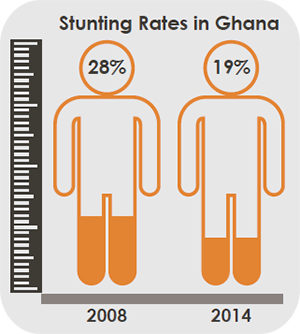
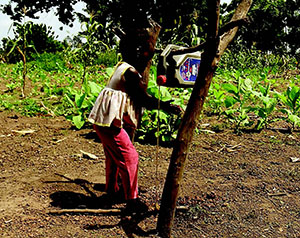
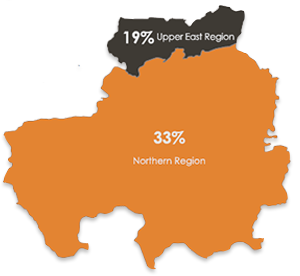
The Government of Ghana has committed to significantly reducing the persistent problem of chronic malnutrition (a cause of stunting) in young children, which is measured by poor linear growth. Between 2008 and 2014, stunting rates in Ghana fell from 28% to 19%; however, a disaggregated look shows that the high rates in the Northern Region increased from 32% to 33%(DHS, 2008 and 2014).In the Upper East Region, stunting rates declined, but they remain high (19%)1 in comparison to other regions. Anemia is another significant challenge in Ghana. Anemia is one of the top 10 causes of morbidity and mortality in the country, and especially affects children and women. Rates of anemia in Ghana declined between 2008 and 2014, but they remain high and are particularly acute in the northern part of the country. In 2014, 66% of children in Ghana were anemic, including 82% of children under 5 years of age in the Northern Region and 73% of children in the Upper East Region. Among pregnant and lactating women 15-49 years of age, the picture is similar. Nationally, 42% of women were anemic, with higher prevalence in the Northern and Upper East regions, at 47.5% and 40% respectively(DHS, 2008 and 2014).
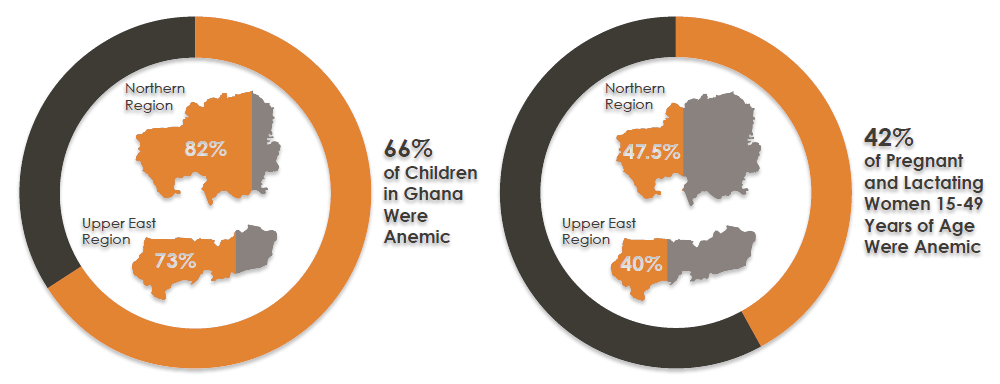
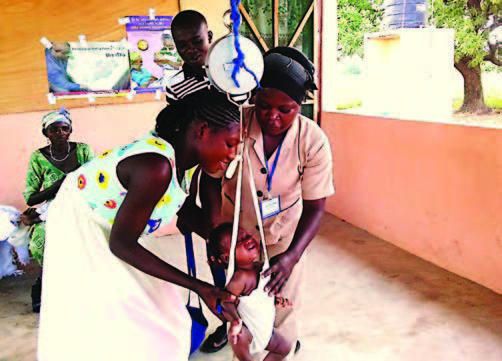
About SPRING
The SPRING project is a seven-year cooperative agreement dedicated to strengthening global and country efforts to scale up high-impact nutrition practices and policies and improve maternal and child nutrition outcomes. SPRING provides state-of-the-art technical support focused on preventing stunting and maternal and child anemia in the first 1,000 days, from pregnancy through two years of age. The project links the nutrition, WASH (water, sanitation, and hygiene), and agriculture sectors, and employs social and behavior change communication approaches at all levels.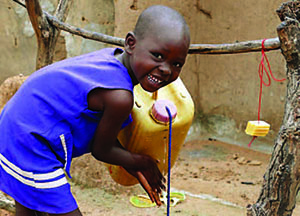
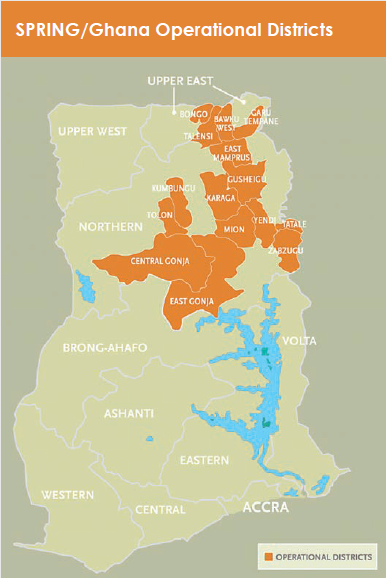
In 2014, the SPRING project began a collaboration with the Ghana Health Service (GHS) to address stunting and anemia in northern Ghana. Operating within the USAID Feed the Future (FTF) zone of influence (ZOI) in 15 districts in Ghana’s Northern and Upper East Regions, SPRING/Ghana combined the rollout of critical GHS activities with other actions designed to alleviate the high rates of stunting and anemia. These actions addressed the leading causes of both conditions: poor diets of women and children (especially low diet diversity), high rates of illness (especially malaria), and poor sanitation infrastructure and practices that lead to multiple intestinal infections and worms.
Focus on the first 1,000 days
In line with global programming, SPRING’s stunting and anemia reduction efforts focus on the segment of the lifecycle called the “first 1,000 days,” which encompasses pregnancy and the child’s first two years. This window of opportunity is the time to take action to prevent stunting in young children because it is a time of rapid growth and development.
Failure to ensure adequate nutrition during the first 1,000 days can lead to a child’s diminished capacity to learn, poor performance in school, and increased susceptibility to infection and disease. The damage caused during the first 1,000 days is irreversible, severely reducing a child’s potential to realize a healthy and productive life and, in many cases, prolonging the cycle of intergenerational poverty.2
SPRING/Ghana’s hallmark integrated 1,000-day household approach
What is it?
In response to the GHS priorities and global best practices for stunting prevention and anemia control, SPRING/Ghana developed an integrated, multi-sectoral program that links the nutrition, WASH, and agriculture sectors and focuses on priority household actions that address the three underlying causes of undernutrition: 1) inadequate care practices in the household, 2) infrequent use of health facilities and poor WASH infrastructure, and 3) lack of access to nutritious foods. Priority behaviors tied to each cause are listed by sector in table 1.
Table 1. Targeted 1,000-day Nutrition Behaviors by Priority Sector
| Nutrition Sector |
|---|
| Water, Sanitation, and Hygiene (WASH) Sector |
| Agriculture Sector |
Increase nutrient consumption through adequate infant and young child feeding:
Prevent anemia in pregnant women:
|
Prevent diarrheal diseases and intestinal dysfunction leading to poor nutrient absorption:
|
Promote safe farming for healthy food:
|
To hasten the adoption of the key behaviors—and recognizing that addressing stunting and anemia requires sustained efforts on multiple fronts—SPRING/Ghana went beyond the usual programming efforts that focus only on each sector’s adoption of 1,000-day actions. Instead, after 1,000-day programming was established within a sector, SPRING/Ghana promoted the coordinated delivery of these programs. In selected communities, SPRING/Ghana’s district personnel coordinated an implementation scheme to ensure the delivery of an integrated package of products, services, and information from all three sectors at the same time where the need was greatest: in poor, isolated communities and households with pregnant and lactating women and children under two—i.e., 1,000-day communities and households.
To operationalize this approach, each year SPRING/Ghana met with leaders in the 15 districts to select the communities that would receive the integrated, multi-sectoral 1,000-day household package. To be selected, a community had to meet the following criteria:
- Had not previously received a community-led total sanitation (CLTS) intervention, or had failed to achieve open-defecation-free (ODF) status after previous efforts
- Had not received direct community-based nutrition program support from the district government or another partner
- Was considered geographically isolated or hard to reach
- Had hosted a Government of Ghana- or UNICEF-supported cash transfer program, such as the USAID-funded Livelihood Empowerment Against Poverty (LEAP 1,000) program.
In the first two years of SPRING/Ghana’s coordination efforts, each district selected 10 communities to participate. In the third year, each district selected seven communities to allow time for thorough supervision of communities selected early in the program. Over a three-year period, 405 communities across the 15 districts participated in this coordinated, multi-sectoral integrated approach to nutrition improvement.
Strategy and region-wide program underpinning the integrated 1,000-day household approach
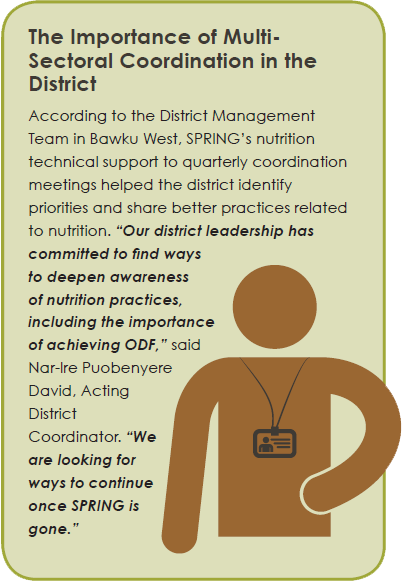
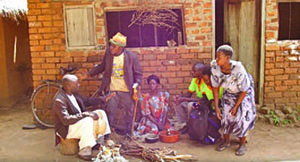
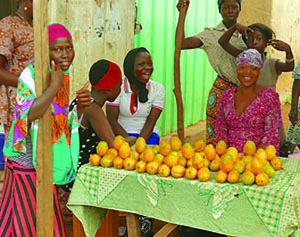
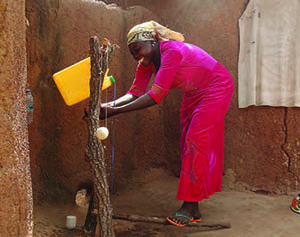
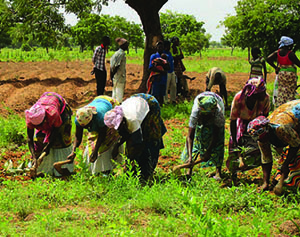
The ability of individuals and family units to adopt targeted nutrition, WASH, and agriculture behaviors is impacted by their immediate community and the larger social and institutional environment. SPRING/Ghana used an ecological lens (a look at needs across the full programming environment) during the design and implementation of activities across the Northern Regions. Seeing through this lens, we targeted activities to influence the attitudes, perceptions, and skills of all program actors. This ensured that the necessary services, policies, and procedures were in place to support the intense community and family work needed to reach the program’s behavioral goals.
In 2013-2014, the SPRING/Ghana team focused on two areas: strengthening district governance mechanisms to support nutrition, and developing the program and institutional capacity of key actors within each sector.
Highlights of this region-wide support to a 1,000-day agenda include:
Improved Coordination and Support among Regional and District Stakeholders
SPRING/Ghana collaborated with Government of Ghana partners at the regional and district levels across sectors to enable them to adopt and maintain necessary activities to improve nutrition among women and children. This collaboration included assistance to help coordinate agendas and workplans and to provide logistics and technical assistance to District Assemblies. Throughout implementation, SPRING/Ghana convened quarterly coordination meetings that tracked partner progress against nutrition program performance indicators, allowing SPRING to adjust plans to better meet district needs.
To bring attention to the serious problem of stunting in northern Ghana and the importance of nutrition during the first 1,000 days, SPRING/Ghana produced a documentary-style video entitled When a King has Good Counselors, His Reign is Peaceful. This video recognizes the important role of men in sanctioning actions and controlling resources, and carefully depicts ways that male leaders and positive male role models can address the immediate and underlying causes of stunting. Seen by more than 1,600 influential leaders across the 15 districts, the video has been shown widely.
After viewing the video, leaders participated in a facilitated discussion and committed to take specific actions that would enable their communities to address stunting and anemia. Commitments by these leaders have included encouraging men to: 1) support exclusive breastfeeding for children up to six months old, 2) help their communities identify resources to build latrines and/or tippy taps (handwashing stations), and 3) speak publicly about the importance of maintaining both good nutrition for the youngest children and good hygiene in homes and compounds.
After viewing the video, leaders participated in a facilitated discussion and committed to take specific actions that would enable their communities to address stunting and anemia. Commitments by these leaders have included encouraging men to: 1) support exclusive breastfeeding for children up to six months old, 2) help their communities identify resources to build latrines and/or tippy taps (handwashing stations), and 3) speak publicly about the importance of maintaining both good nutrition for the youngest children and good hygiene in homes and compounds.
Improved Quality of Services by the Nutrition, WASH, and Agriculture Sectors
In the nutrition sector, programming emphasized supporting health facilities with the rollout of the GHS-UNICEF infant and young child feeding (IYCF) package, a standard set of activities to improve the capacity of health providers to counsel caregivers in appropriate IYCF and to establish community-based mother-to-mother support groups. SPRING/Ghana trained more than 1,500 district health staff in the IYCF program and in actions to prevent anemia in pregnancy.
The SPRING/Ghana team developed short counseling-support videos on breastfeeding and enriching foods, and a serial radio program on IYCF (The Shrubs of Today Become Tomorrow’s Forest). To help districts provide follow-up support to health providers, SPRING also developed a set of supportive supervision and coaching tools and a quality improvement (QI) approach for health facilities in 7 of the 15 districts. The facility QI tools identified and tracked opportunities to improve processes and activities, and to consistently measure a facility’s progress against capacity building and quality improvement targets.
Within the WASH sector, SPRING/Ghana supported the rollout of the government community-led total sanitation (CLTS) program and developed a set of actions known as WASH 1,000, which included supporting latrine construction, improved water sources, and hygiene actions. SPRING/Ghana trained more than 600 district environmental health staff in CLTS and facilitated the use of the national certification process to recognize and track communities’ achievement of open defecation free (ODF) status. SPRING/Ghana developed a community drama videotaped for wide-scale viewing to create demand for improved hygiene practices. This video was shown to communities by teams conducting CLTS triggering events.
In the agriculture sector, SPRING/Ghana led farmer field schools in an initiative to reduce aflatoxin contamination of groundnuts. We chose groundnuts because they are grown by women, are a popular food for child feeding, and are often contaminated with aflatoxin, which is associated with high rates of stunting. SPRING/Ghana’s support of aflatoxin reduction efforts focused on training farmers on pre- and post-harvest best practices. SPRING/Ghana trained more than 300 district Ministry of Food and Agriculture (MoFA) staff as trainers on aflatoxin prevention, who in turn reached over 20,000 farmers through the farmer field schools. SPRING/Ghana also developed radio spots and short videos to be used to support training and community activities.
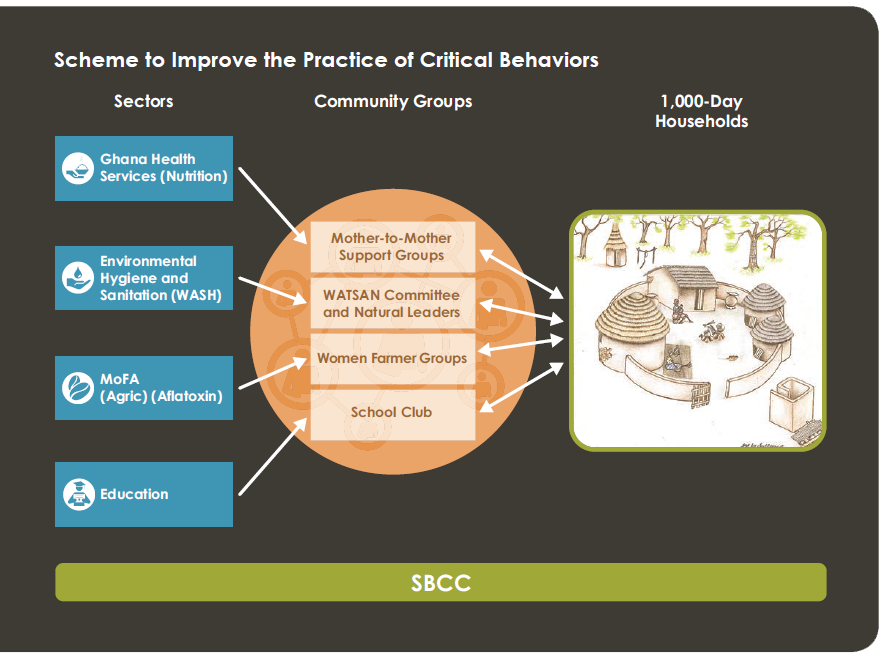
The integrated 1,000-day approach at work at the community and household levels
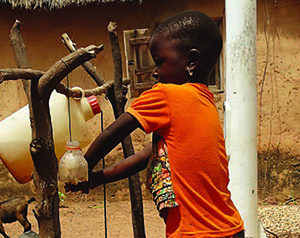

Once the groundwork was laid with district leadership and service providers, SPRING/Ghana’s district coordinators held a meeting with top district personnel representing key sectors (such as the District Coordinating Director, MoFA, GHS, Community Development, Environmental Health, Ghana Education Service, and District Planning Units) to introduce the integrated 1,000-day household approach and the selection criteria for 1,000-day households and communities. The SPRING/Ghana district workplans and budgets were shared, discussed, and modified according to input from district partners.
Using the SPRING community selection criteria (described above), the multi-sectoral government-led team conducted an initial selection of ten 1,000-day communities. SPRING verified that the communities met the criteria and made adjustments as necessary. This selection process included chiefs and traditional leaders who authorized their community’s participation. Following selection, a cadre of multi-sectoral community workers was identified for training, including Agricultural Extension Agents, natural leaders, a water and sanitation management team (WSMT), and community health volunteers.
The integrated 1,000-day household approach was implemented in each of the selected communities. Implementation included the introduction, simultaneous implementation, and monitoring of four key community activities, all supported by communication activities and materials designed to motivate demand, modify attitudes, and improve skills and behaviors. The centerpiece activities and communication supports were—
- Viewings of the advocacy video, When a King Has Good Counselors, His Reign is Peaceful, to introduce concepts about child growth and stunting to selected communities, and to mobilize leadership to make commitments that can improve the well-being of women and young children and, therefore, of their community.
- WASH 1,000 sensitization and follow-on activities to guide the CLTS process and ODF certification, promote the use of tippy taps, encourage latrine construction and utilization, and improve general household hygiene.
- Mother-to-mother support group meetings, led by community health volunteers, to encourage mothers in 1,000-day households to discuss and help each other to improve infant and young child feeding and WASH practices in the home.
- Community-based agriculture activities comprising farmer field school trainings that target members of 1,000-day households who are small shareholder farmers. These trainings cover good agronomic practices to prevent aflatoxin contamination in groundnuts, reinforce nutrition and WASH behaviors for 1,000-day households, and promote nutrient-rich crops such as vitamin A maize and orange-flesh sweet potatoes.
- Complementary media materials, including the community WASH and agriculture videos (community dramas produced for video), the radio serial drama The Shrubs of Today Become Tomorrow’s Forest, and shorter dramatic radio spots on agricultural practices.
The steps involved in implementing the integrated 1,000-day household approach in a community followed a series of steps, described below:
Step 1: Obtain commitments for the integrated 1,000-day household approach at the community level.
SPRING district coordinators conducted the first meetings with chiefs and other community opinion leaders, often in connection with a CLTS/WASH 1,000 “pre-triggering” event. During this meeting, the district coordinator screened the advocacy documentary on stunting and the WASH 1,000 community video. Each screening was followed by an open discussion with community leaders. Following the discussion, leaders were asked to commit to take action to address stunting in their communities. These commitments were often related to implementing WASH actions. Community leaders generally created an action plan and district coordinators recorded basic information about the community.
Step 2: Initiate WASH and agriculture activities.
As CLTS triggering activities continued in chosen communities, SPRING/Ghana and the district Environmental Health and Sanitation Unit trained the natural leaders who were chosen by the community. District Agricultural Extension Agents selected farmers, usually women, from 1,000-day households to participate in farmer field schools held in the community.
Step 3: Establish or re-invigorate community health volunteers and mother-to-mother support groups.
Health workers from community-based health planning and services (CHPS) facilities came together with community leadership and selected community health volunteers (CHVs) from each community. Together these health workers and CHVs established, or reestablished, mother-to-mother support groups in the community. These support groups provided a platform for sharing experiences on many topics during their monthly meetings. One of the first topics addressed was infant and young child feeding. SPRING/Ghana trained the CHVs in the support group component of the IYCF national package and provided the CHVs with discussion guides for the group sessions and counseling cards for individual household discussion. Each support group also received the serial radio program on IYCF on memory cards, along with radio sets. The radio episodes were played and discussed during group sessions.
Step 4: Continued implementation of the integrated 1,000-day household activities.
While SPRING/Ghana district staff helped initiate the activities and provided periodic implementation support, all community 1,000-day household nutrition, WASH, and agriculture activities were conducted by community agents (CHVs, natural leaders, and the WSMT) with support from chiefs and religious and traditional leaders, and with technical assistance from government health workers, environmental health agents, and agriculture extension agents.
Table 2. Examples of the commitments made by community leaders after watching and discussing the videos on childhood stunting and WASH
| Thematic Area | Specific Actions (Activities) |
|---|---|
| Child feeding | Encourage breastfeeding for all babies in the community/educate on the benefits |
| Encourage men to support their wives to breastfeed | |
| Encourage exclusive breastfeeding of all future children | |
| Encourage/educate mothers to provide diverse foods for their children | |
| Encourage fathers to provide liver for their children | |
| Safe disposal of feces (WASH) | Educate and mobilize community members on the need for constructing latrines |
| Teach people how to construct latrines | |
| Educate people to keep animals away from their compounds | |
| Teach mothers to properly dispose of child feces | |
| Safe household water (WASH) | Counsel people on the dangers of contaminated water |
| Educate community members to boil water before drinking | |
| Teach people to cover household water | |
| Educate people to use clean containers for storing water | |
| Handwashing with soap (WASH) | Teach people the critical times for handwashing |
| Help community members to construct tippy taps | |
| Educate people on the dangers of not washing hands | |
| Demonstrate how to wash hands properly |
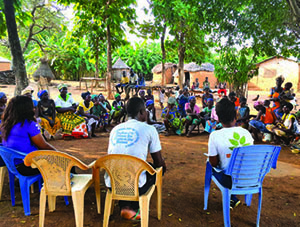
Mother-to-Mother Support Groups (MTMSG) at Work
Each SPRING MTMSG had 15 members, which included pregnant or lactating women from 1,000-day households, caregivers of children under two years of age, two traditional birth attendants, and at least two grandmothers from the community, plus a CHV serving as facilitator. With supervisory support from health workers, trained CHVs used the SPRING discussion guide and the radio serial drama episodes during each meeting to lead groups through a series of sessions covering IYCF and hygiene practices. Participants were encouraged to discuss strategies, practice key behaviors at home, and to support each other to overcome challenges.
In one MTMSG in Gabuliga community in the Bawku West District, group members say the meetings helped increase their awareness about child nutrition. “We didn’t know about the importance of mixed foods, and that giving food like liver helped to prevent stunting.” The group was encouraged to find doable and affordable strategies to provide mixed foods, and together, they decided to help each other to cultivate soybeans to provide a source of protein for their children.
Step 5: Monitoring and supervision of communities using the integrated 1,000-day approach.
SPRING/Ghana provided logistical support, tools, and resources to enable Government of Ghana district partners to closely monitor and supervise community activities. SPRING/Ghana staff also followed up with community leaders to track the results of their commitments made after viewing the advocacy video.
Results and lessons from implementation of the integrated 1,000-day household approach
Over three years and across 15 project districts, SPRING/Ghana raised the awareness, knowledge, and skills of development workers from multiple sectors, key leaders, and families. The result was many commitments to and the adoption of nutrition-enhancing behaviors. In accepting the challenge of stunting and anemia prevention programming, SPRING/Ghana went beyond implementing activities siloed by sector. The integrated 1,000- day household approach ensured that formerly disparate actions were delivered to households in a coordinated fashion, making it possible for 1,000-day families to benefit from combined, synergistic inputs to realize better nutritional outcomes.
Executing this timed geographic co-location of activities is difficult, especially across sectors. In 405 of the most isolated communities across the 15 districts, the SPRING/Ghana team, together with Government of Ghana sector leadership, offered services and activities to selected communities under an integrated program umbrella on a coordinated timetable.
There is anecdotal evidence of heightened and sustained community awareness, interest, and commitment to nutrition and stunting prevention under this integrated 1,000-day household approach. A rigorous assessment is underway and more will be known in quantitative terms about the impact in late 2017. In the meantime, a qualitative look at the process and progress offers several important lessons for this type of integrated multi-sectoral programming at the community level.
Lessons learned about integrated multi-sectoral nutrition programming at the community level
1. Strengthening the enabling environment and giving key actors information and skills to deliver services or activities is the foundation for further coordination.
Clarifying the government’s program, especially in the nutrition and WASH sectors, coupled with district-level participatory planning and coordination led by SPRING/Ghana, allowed for rapid spread of key skills among regional and district teams in each sector and facilitated their willingness to collaborate together at the community level. The documentary-style video on stunting that promoted the role of men and the importance of multi-sectoral action in addressing the problem provided for a common understanding among development workers and natural and traditional leaders and created the required commitment. This shared point of view, coupled with “ready” professionals meant that key support was available to 1,000-day families in the communities.
2. Coordination is difficult; flexibility is essential.
SPRING/Ghana is mandated to work across sectors to address stunting. However, when it came to programming, districts tended to favor one sector. Because of the prevalence of poor sanitary practices and the government’s emphasis on improving sanitation infrastructure nationwide, many district leaders were most concerned about support for sanitation and were most motivated by the WASH component of the SPRING package. The other sectors—nutrition/health and agriculture—did not receive the same level of attention. SPRING leveraged the interest in sanitation, broadening sanitation work to focus on WASH 1,000, and used WASH components as an entry point for community engagement.
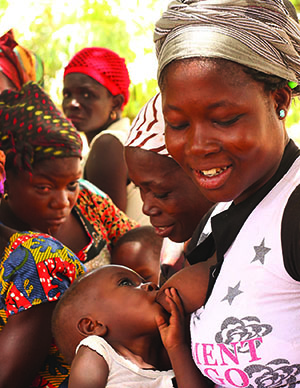
At the district level, the willingness of SPRING to support sanitation projects established trust and a good working relationship that opened the door for other programming, such as the farmer field schools. Likewise, at the community level, under the integrated 1,000-day household approach, WASH activities were often the first ones introduced in a community. This provided an opening for leaders of mother-to-mother support groups to spread the word about sanitation and hygiene as well as nutrition.
Whether at the district or community level, listening to expressed needs and interests is the starting point for programming. As progress is made, trust is gained and other actions are possible.
3. Creating a plan with implementation milestones for the communities taking up the integrated 1,000-day household approach is critical to ensuring the inputs for impact.
In collaboration with district partners, SPRING/Ghana selected 10 communities a year to receive the integrated 1,000-day household package. Each community had a program of activities that followed a generic plan with modifications depending on the local situation and priorities identified by local leaders. The variation in plans made it important to closely monitor implementation to ensure that inputs from all sectors were implemented within a year of initiation. Representatives from Government of Ghana district-level ministry offices conducted follow-up visits to track progress toward ODF certification, mother-to-mother support group formation, and action on commitments made by community leaders. They scheduled community visits and made the visits count for both routine monitoring and quality improvement.
Keeping to supervision schedules was difficult: government workers juggle many demands, and in the north, they face a difficult physical environment and limited resources. These follow-up visits were crucial for appropriate resource allocation and for decisions about how many new communities to take on. Moving into the third year of the program, SPRING/Ghana learned that the pace of expansion needed to slow even though progress was being made. When communities fell behind, district groups were clear that new communities should not begin activities if those already participating were struggling to initiate or maintain their activities or needed additional resources. Being flexible with plans and favoring quality over quantity was critical to the full implementation of the approach.
To download this brief, please find link here.
Footnotes
1 Ghana Statistical Service (GSS), Ghana Health Service (GHS), and ICF International. 2015. Ghana Demographic and Health Survey, 2014. Rockville, MD, USA: GSS, GHS, and ICF International.
2 The 2008 Lancet Series on Maternal and Child Nutrition.